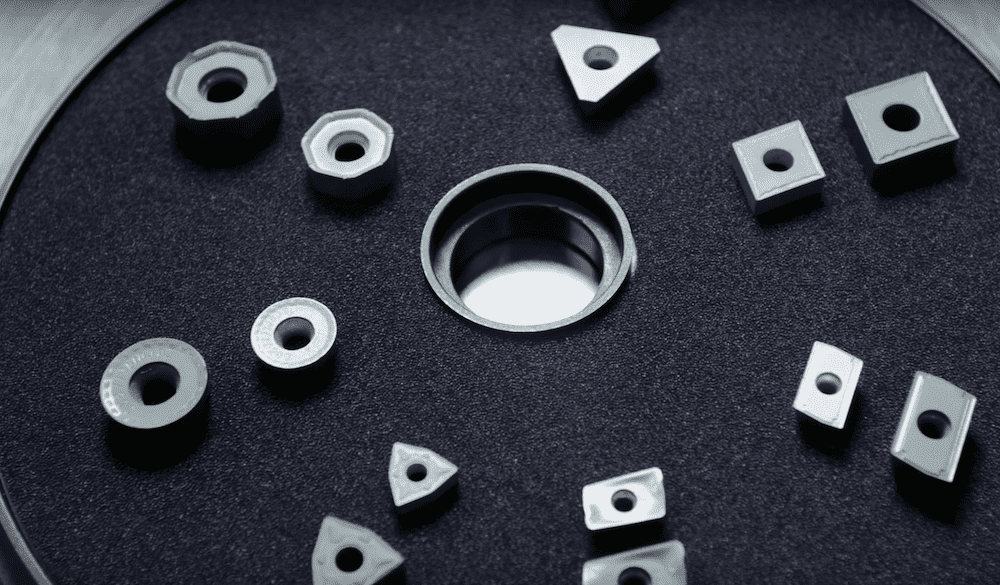
[Image above] Cobalt is a main material used as the binder in cemented tungsten carbide. The screenshot is from a video describing how cemented carbide tools are fabricated. Credit: Sandvik Coromant, YouTube
When I think of uses for the metal cobalt, lithium-ion batteries are the first application that comes to mind. Cobalt stabilizes the cathode in lithium-ion batteries by compensating for the charge when lithium ions arrive or depart during cycling.
However, cobalt also finds widespread application in the machining industry as a binder for cemented carbides. Cemented carbides are metal matrix composites used extensively as cutting tool materials because of their high hardness, wear resistance, and fracture strength. Tungsten carbide–cobalt (WC–Co) cemented carbides, in which cobalt is the cementing phase between the tungsten carbide grains, are one of the main types of cemented carbides used.
Like its use in lithium-ion batteries, though, the use of cobalt in cemented carbides has some drawbacks. For example, the solubility of many workpiece materials in cobalt causes WC–Co to have high sensitivity to crater wear, especially when machining steels. Plus, high-temperature operation of the cobalt-bonded cemented carbide can result in tool failure due to plastic deformation caused by softening of the binder phase.
These drawbacks, in addition to poor corrosion resistance, high cost, and high toxicity of cobalt, have inspired researchers to explore ways to reduce or eliminate the cobalt binder.
Early investigations on alternative binders mainly involved iron, nickel, and their alloys. Intermetallic materials such as titanium aluminide and aluminum nitride were considered as second-generation alternative binders.
Recently, ceramic phases have started attracting significant attention as binders. Studies on several ceramic-bonded tungsten carbides have found they exhibit superior hardness, corrosion/oxidation resistance, and high-temperature performance in comparison with cemented carbides with metal binder or intermetallic binder.
Rapid development of nanopowder technology has led scientists to start researching nanoceramic-bonded cemented carbides as well, following the hypothesis that nanoparticles may improve the densification and properties of cemented carbide. Now, a recent study dives further into the feasibility of using nanoceramics as a binder.
The authors of the recent study come from Shandong University in China. In the paper, they selected nano aluminum oxide (Al2O3), yttria-stabilized zirconium dioxide (ZrO2), and magnesium oxide (MgO) as the binders to investigate.
Following microstructural and mechanical analyses of the nanocomposite cemented carbides, which were fabricated through hot-pressing sintering, the researchers determined that all three ceramic binders led to cemented carbides with near-full densification. In addition, the ceramic-bonded cemented carbides achieved excellent comprehensive mechanical properties, specifically
- WC-6Al2O3: hardness of 23.5 GPa, flexural strength of 1,173.6 MPa, fracture toughness of 8.13 MPa·m1/2
- WC-6ZrO2: hardness of 22.6 GPa, flexural strength of 1,229.7 MPa, fracture toughness of 9.35 MPa·m1/2
- WC-6MgO: hardness of 21.1 GPa, flexural strength of 906.3 MPa, fracture toughness of 8.62 MPa·m1/2
Looking closer, the researchers determined that the ceramic-bonded cemented carbides used interlacing distribution of crack deflection, crack bridging, and crack branching as toughening mechanisms. In the case of the zirconia-bonded tungsten carbide, stress-induced transformation toughening significantly enhanced the toughness as well.
Based on these results, “These ceramic bonded WC materials may be promising candidates for high-speed machining tools,” they conclude.
The paper, published in Journal of Alloys and Compounds, is “Nano-ceramic replacing cobalt in cemented carbide as binder phase: Is it feasible?” (DOI: 10.1016/j.jallcom.2021.162968).
